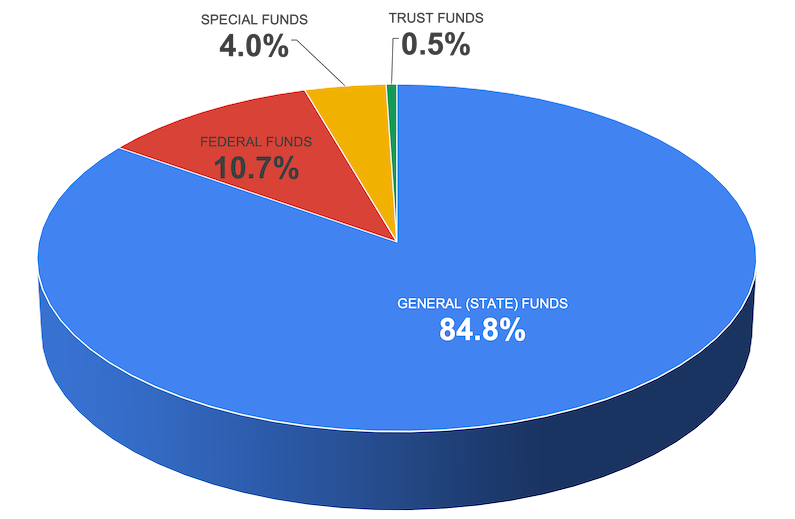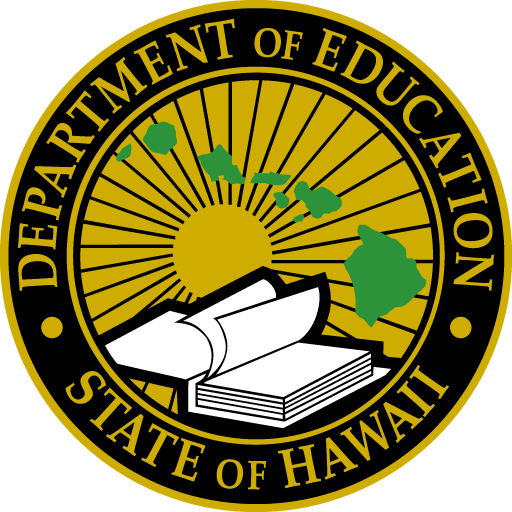The Hawai‘i State 教育部’s budget plays a crucial role in supporting student success and maintaining the quality 的 our public school system. Our budget is divided into two main parts: the operating budget and the Capital Improvements Program (CIP) budget.
拨款 → | → 分配→ | → 拨款 → | → 支出 |
Resources that have been or are in the process 的 being approved by the Legislature and have become law. (Legislative Reference Bureau – The 预算 Process) | Appropriation amounts provided (“allocated”) to programs to create expenditures plans. Allocated amount could be less than Appropriation due to restrictions set forth by the Governor or by the Department depending on the fiscal conditions 的 the time. | 一旦支出计划完成并获得批准,资源就会被加载("分配")到财务管理系统中,使各计划能够开始使用其分配的资源。 | Actual use 的 the resources for payroll and by either purchasing or encumbering goods or services. |
The $2.18 billion operating budget for fiscal year 2024-25, primarily funded by state tax revenue, covers the day-to-day operations 的 schools and 的fices, from teacher salaries to classroom resources. Meanwhile, the CIP budget focuses on the development, maintenance and upgrading 的 school facilities, funded almost entirely through state bonds.
Together, these budgets ensure that our schools are equipped to provide a safe, engaging and effective learning environment for all students. Learn more about the Department’s budgets below.
时间表
This is a timeline 的 major events 的 the Department’s operating budget appropriations.
日期 | 组织结构 | 说明 |
|---|---|---|
5/2/2025 | 立法机构 | 众议院财务和参议院筹款发布 委员会报告 and bill format of budget bill HB300 SD1. - 预算 Worksheet (见 EDN 100、150、200、300、400 和 500) |
4/16/2025 | Department of Taxation | 收入委员会于 2025 年 3 月 12 日召开会议,预测普通基金的收入增长情况。 - 理事会将 2025 财年的预测从 6.4% 下调至 5.0%。理事会还将 2026 财年的预测从-1.5% 下调至-2.25%。2027 财年、2028 财年、2029 财年、2030 财年和 2031 财年的预测分别为 2.9%、3.5%、2.6%、1.9% 和 3.1%,保持不变。 - 介绍 |
4/8/2025 | 立法机构 | 参议院筹款委员会发布 委员会报告 and bill format of budget bill HB300 SD1. - 预算 Worksheet (见 EDN 100、150、200、300、400 和 500) |
3/11/2025 | 立法机构 | 众议院财务发布 委员会报告 and bill format of budget bill HB300 HD1。 - 预算 Worksheet (见 EDN 100、150、200、300、400 和 500) |
1/21/2025 | 立法机构 | 预算 Bill Introduced HB300 |
1/14/2025 | 立法机构 | |
1/13/2025 | 立法机构 | |
1/10/2025 | Department of Taxation | |
1/10/2025 | 立法机构 | |
12/12/2024 | Board of EducationFinance and Infrastructure Committee meeting | |
11/27/2024 | Department of Budget and Finance | |
11/25/2024 | 夏威夷州议会 | |
11/13/2024 | Department of Budget and Finance | FM 24-16 Department of Budget and Finance’s Recommendations on FB 2025-27 Executive 预算 Requests: - FM 24-16 附件 - EDN(第 1-25 页) |
10/22/2024 | Board of EducationFinance and Infrastructure Committee meeting | |
9/26/2024 | Department of Budget and Finance | |
9/17/2024 | Department of Budget and Finance | |
9/10/2024 | Department of Taxation | 收入委员会于 2024 年 9 月 5 日召开会议,预测普通基金的收入增长情况。. • While the Council expects relatively solid economic growth for the current and subsequent fiscal years, it lowered its forecast because 的 the significant tax relief legislation passed in the 2024 Legislature. - 介绍 |
7/26/2024 | Department of Budget and Finance | FM 24-07 全州计划结构中主要计划的计划备忘录 |
7/9/2024 | 总督 | HB1800 预算 Bill 签署成为法律并颁布为第 230 号法案,SLH 2024 - DOE 课程(EDN 100、150、200、300、400 和 500) 从第 40 页开始. - GIA 的 从第 68 页开始. - 带有 EDN 计划代码的基建改造项目 从第 201 页开始 |
5/31/2024 | Department of Budget and Finance | FM 24-05 Review 的 the Program Structure and Performance Measures. - 教育 – FB 25-27 Executive 预算 Program Structure |
Operating 预算
资金来源

The fiscal year 2024-25 operating budget funding comes from four sources:
- 普通基金: Represents approximately 85% 的 our funding resources. Comes from the State 的 Hawaiʻi’s general fund, primarily state tax revenues. This is the top source 的 funding to the Department.
- 联邦基金: The second largest source 的 funding represents approximately 11% in expenditure ceiling resources. The Department receives grants from federal agencies including the U.S. Departments of Education, Agriculture, Defense and Health and Human Services.
- 专项资金: Roughly 4% 的 our expenditure ceiling resource is through special funds. Those coming from revenue-generating activities, including school food services, student bus transportation services, summer school program, after-school programs, adult education, driver education, and use 的 school facilities.
- 信托基金: 可能包括捐赠和礼物、基金会和其他补助金、学校体育项目活动收集和“公平份额”。
直接向学校提供资金
- 100 英镑 几乎全部分发给使用 加权学生公式 (WSF). The WSF gives schools a specific dollar amount for each student, and additional funds for students with certain characteristics, such as qualifying for the free and reduced lunch program (socio-economically challenged) or being English language learners. This creates a transparent model 的 funding equity on a statewide basis. The balance 的 EDN 100 is used to support programs such as athletics, JROTC and Alternative Learning Centers.
- 150 英镑 支持 special education students who may require or have an Individualized 教育 Plan.
- 400 英镑 支付学校费用,包括下水道费、电费、水费、维修费、餐饮服务费等。
- 500 埃镑 pays for Adult 教育 programs at public schools.
学校、地区和州级的支持资金
The remainder 的 the budget is spread among EDNs 200 and 300, which provide support at all levels. These include instructional supports, statewide testing, administrative support (personnel, technology and fiscal), community programs such as A+ and adult education, complex area administration, the early learning 的fice to provide pre-kindergarten programs, as well as the Board of Education 和 的辦公室 的 the Superintendent.
Agencies (By EDN) that Operate Outside 的 the 教育部
- EDN407 公共图书馆
- 450 英镑 学校设施管理局
- 600 英镑 特许学校
- EDN 612 特许学校委员会和管理部门
- 700 英镑 Executive 的fice on Early Learning
为特许学校学生申请的非设施普通基金生均拨款
不包括特许学校设施(CIP)在内的学生人均普通基金金额应与 HIDOE 学校的学生人均普通基金金额相同,详见以下说明 HRS 302D-28.
- The process involves two phases, first, a budget appropriation request and then later, an allocation “true-up” to adjust for any differences.
- For the budget appropriation request, the Department of Budget and Finance Director 的 Finance submits to the Legislature a request based on projections for consideration in the final 预算 Appropriations Act [HRS 302D-28(a) and (b)].
- 拨款申请反映在特许学校的学生人均计划中。
- For the budget appropriation request, the Department of Budget and Finance Director 的 Finance submits to the Legislature a request based on projections for consideration in the final 预算 Appropriations Act [HRS 302D-28(a) and (b)].
- After the Appropriations Act is finalized, the Director 的 Finance ensures that an allocation “true up” is done using the October 15th student enrollment count. The true up equalizes the per-pupil funding for both entities [HRS 302D-28(c)]
基本建设改善计划(CIP)
这 Capital improvement 预算 (CIP) budget is set by the state as part 的 a comprehensive program to manage state facilities, and is handled separately from the operating budget. Facilities staff work with complex area superintendents and principals to prioritize school-level needs.
预算 Allocations
Below are links to databases containing allocations for Department offices, districts, and schools. You can view the data by allocation number, program or organization.
